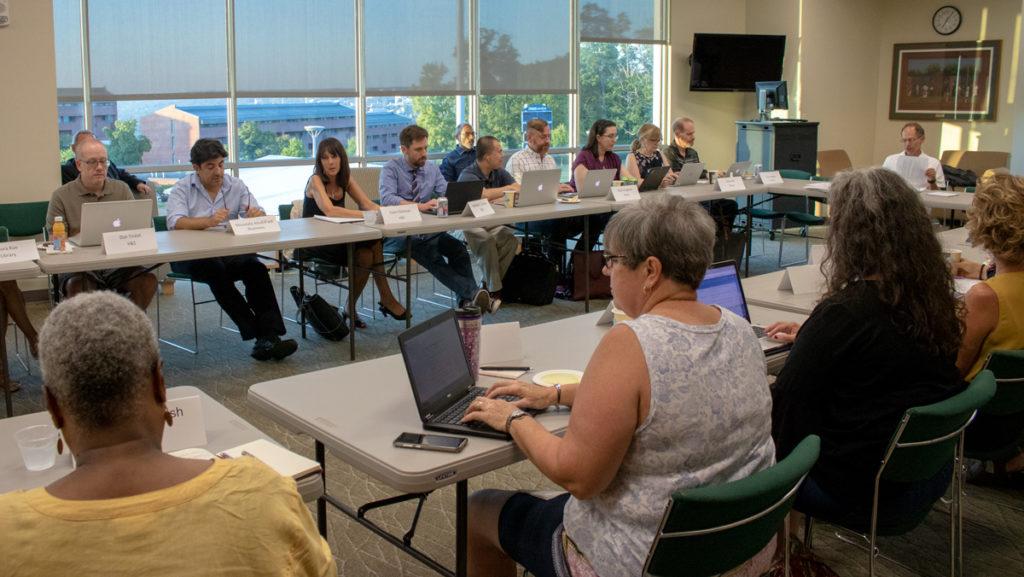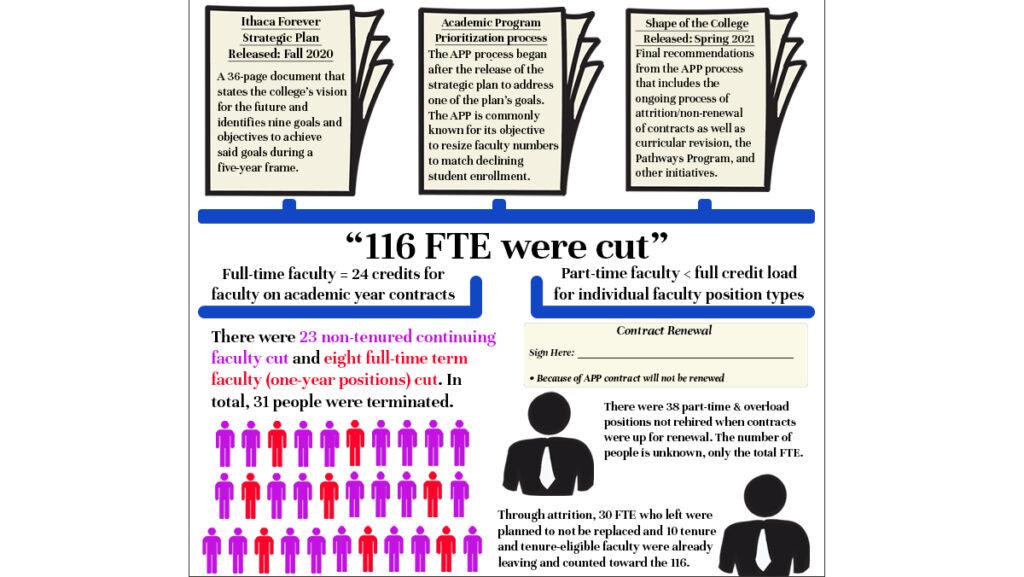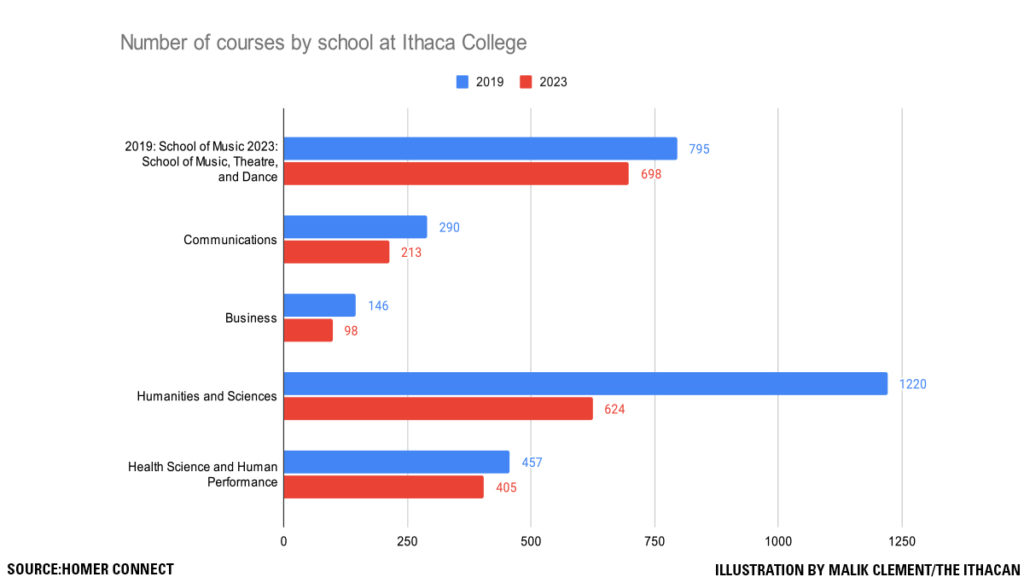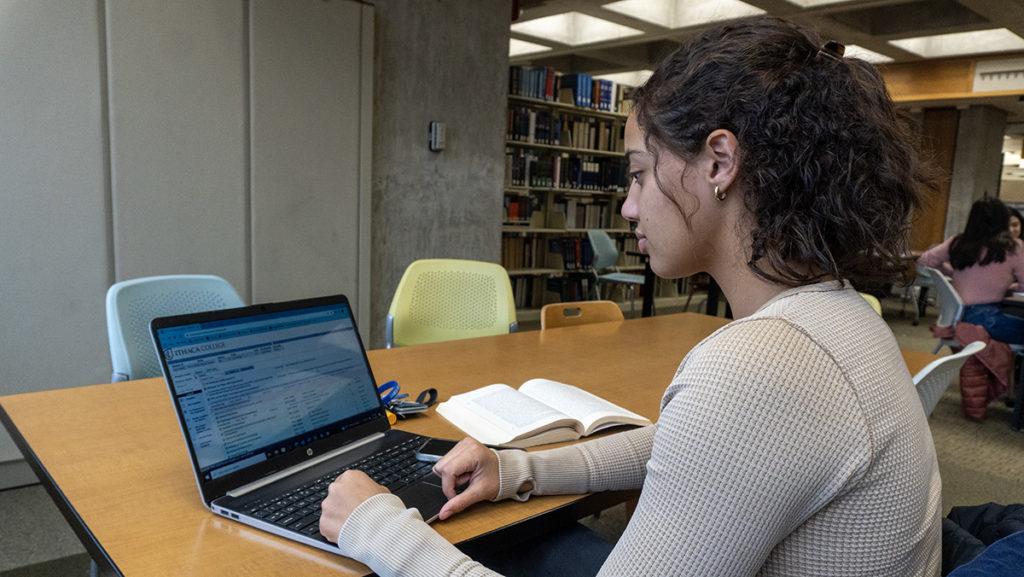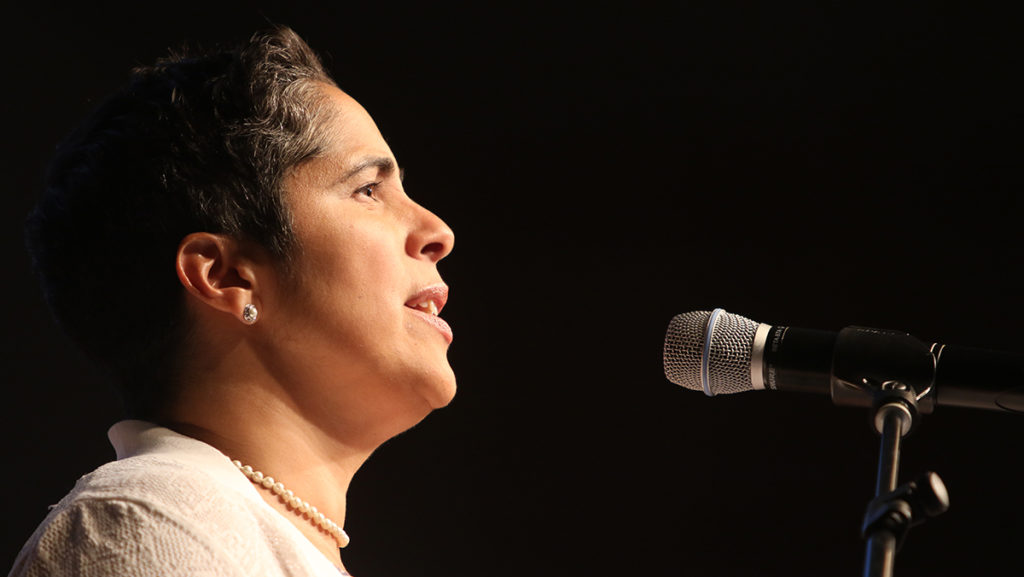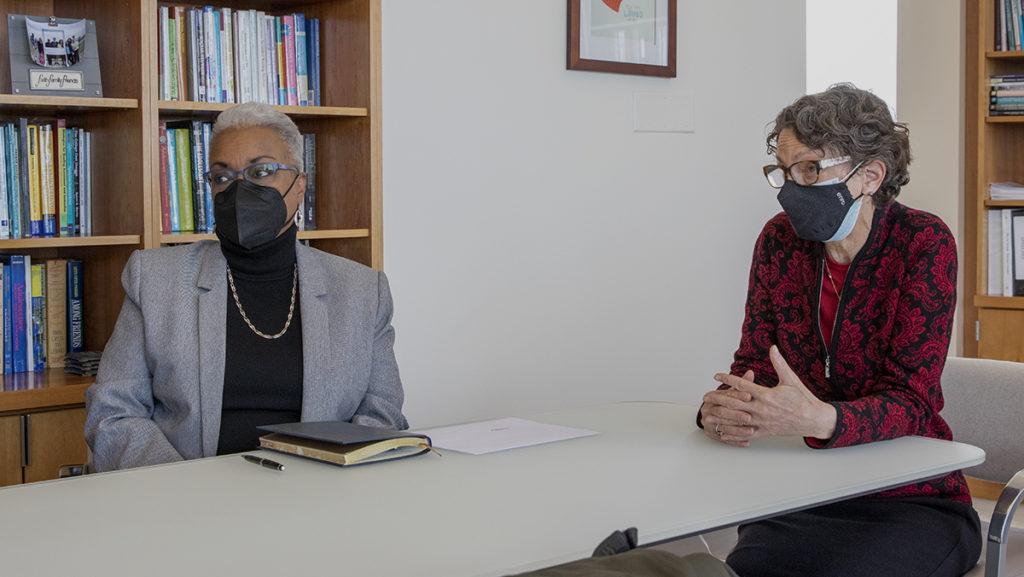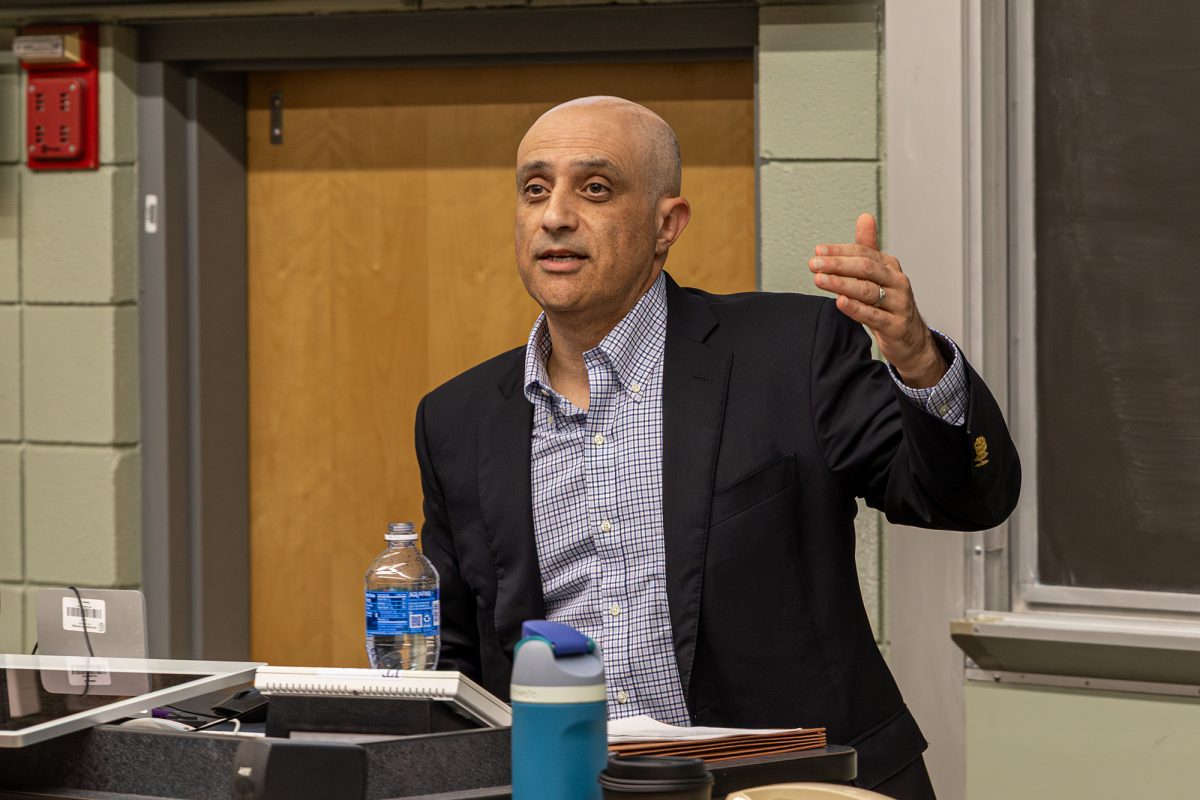Members of the Ithaca College community are concerned about the lack of a collaborative process regarding impending cuts to programs and faculty positions, citing insufficient transparency, a rushed process and uncertainty about the future of the college.
At the Oct. 6 Faculty Council meeting, La Jerne Cornish, provost and senior vice president for academic affairs, announced that approximately 130 full-time equivalent faculty positions will be cut because of decreased enrollment. Enrollment has decreased from 5,852 undergraduate students in Fall 2019 to 4,957 in Fall 2020, according to the Office of Analytics and Institutional Research. More students than in previous years took leaves of absence or deferred their enrollment for Fall 2020.
In a letter to faculty sent Oct. 6, Cornish said the college knew it was necessary to decrease its size before the COVID-19 pandemic began, in accordance with the strategic plan, Ithaca Forever.
Last year, the college created the Academic Program Prioritization Action Group, chaired by Brad Hougham, associate provost for faculty affairs. He said the group was made of faculty, students and staff, who developed a set of guiding principles for the process moving forward. This year, the college created the Academic Program Prioritization Implementation Committee (APPIC) and the Academic Program Prioritization Advisory Committee (APPAC), the two groups that will work simultaneously during Fall 2020 to decide the future of programs at the college.
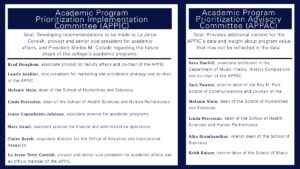
Susan Campbell Baldridge, a strategic planning consultant and professor of psychology and provost at Middlebury College, worked with the college during the strategic planning process and is working with the administration as an “independent ear” during the Academic Program Prioritization (APP) process, Cornish said.
APP Timeline
In an Oct. 20 interview, Cornish said that the APPIC is conducting an examination of the college’s academic programs and that no decisions have been made yet.
“This fall, the implementation committee will be reviewing academic programs, trying to identify patterns to see what programs are strong, which programs generate a lot of student interest, which programs do not generate a lot of interest, and then we’re going to look at those programs,” Cornish said.
Cornish said the APPIC and the APPAC will create a document called “The Shape of the College” by Dec. 31, which will recommend the departments and programs to be discontinued, consolidated, reorganized or grown.
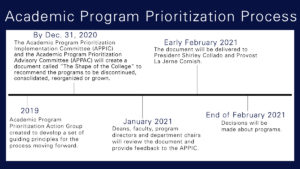
Deans, faculty, program directors and department chairs will review the document and provide feedback to the APPIC in January 2021. The document will then be delivered to President Shirley M. Collado and Cornish in early February, and they will make decisions about programs by the end of February.
Cornish said that the resizing process was supposed to take place over four years but that the COVID-19 pandemic accelerated the college’s need to eliminate positions. She said the process now needs to occur in two years.
“In an ideal world, we would have reached our sustainable size goals by 2024,” she said. “COVID acted as an accelerant to the plan. The budget challenges associated with COVID necessitated that we act much more quickly. … It is painful. No one wants to do this.”
At the Oct. 6 Faculty Council meeting, Cornish said that entire departments may be cut and that even tenured faculty may lose their jobs.
As stated in Section 4.9.8 of the Ithaca College Policy Manual, terminations resulting from the discontinuance of a program will be done in the order of part-time per-course faculty; adjunct faculty; faculty employed by term appointments; non-tenure-track faculty; tenure-eligible faculty; and tenured faculty.
Not an Isolated Problem
The college is not the only institution that has been forced to make cuts to programs and employees. Since February, private education employment is down by 355,000 positions, according to the U.S. Bureau of Labor Statistics. In July, Canisius College in Buffalo, New York, cut approximately 25 faculty members and eliminated nine majors. Also in July, the University of Akron in Akron, Ohio, was one of the first schools in the country to make deep cuts, laying off approximately 20% of the university’s unionized workforce, including nearly 100 faculty members.
Eric Kelderman, senior reporter for The Chronicle of Higher Education, said colleges like Ithaca College are struggling with enrollment. He said that when fewer students enroll, colleges have more faculty members than they need.
“The college just finds itself in a really difficult spot, and it’s trying to get ahead of it by reducing faculty — sort of rightsizing — and putting it on what administrative leaders think is a more sustainable fiscal path,” Kelderman said.
Cornish said that although downsizing was in the plan, the plan did not anticipate this set number of cuts.
“I think that it wasn’t until the number was spoken that some faculty realized for the first time, ‘Wow, we really are going to have to do this,’” she said. “It wasn’t until the number was stated that people got galvanized in certain ways. That is a large number.”
Cornish said that to determine the proper size, the administration looked at historical enrollment, present enrollment and projections for the future.
“We didn’t have a number,” she said. “Go back to that goal. It said determine and maintain an appropriate size. And so the size had to be determined first, and once the size was determined, then we could see what would happen after that. We had no predetermined set amount of faculty to eliminate.”
According to the 2020–21 Facts in Brief, this year’s acceptance rate was 75.7%, the highest percentage recorded in the accessible Facts in Brief datasets, which go back to 2004. The Fall 2020 yield rate — the percentage of applicants who were admitted to the college and decided to enroll — is 10.1%. This is the lowest yield rate in the accessible datasets.
“We would like to be more selective,” Cornish said. “We’re not trying to be an ultra-selective institution. We are a comprehensive college. But we would like to be more selective.”
Concerns about Transparency and the Future
After Cornish announced the impending cuts, the college was featured in The Chronicle of Higher Education, Forbes and InsideHigherEd. This coverage has led to social media backlash.
“Other solutions should have been considered first before eliminating teaching positions,” user @regpecen wrote on Twitter. “How about getting help from faculty for recruitment efforts?”
“Call me when they start “rightsizing” upper admin [sic] positions and/or salaries,” user @bhiller wrote on Twitter.
“It’s likely going to happen to all of us,” user @ErikaGSwain wrote on Twitter. “I still love you @IthacaCollege – it’s never easy being the first in a situation like this, and it’s never easy to make the hard decisions. I’m still proud to be an alum.”
In an Oct. 18 letter to the administration, the Faculty Council Executive Committee (FCEC) criticized the college’s decision to make these cuts and requested that the administration delay them until after the pandemic has passed.
Some students agree that cutting faculty positions may not be the solution. Senior Makarios Allen said he thinks eliminating faculty positions during a pandemic is a bad idea.
“This is something that no one has ever dealt with before, but I feel like there’s still a better way to go about it,” he said. “I don’t feel like the student body itself is being listened to currently, and it’s a little disheartening.”
Cornish said the APPIC and the APPAC created a dashboard to evaluate the college’s programs. This dashboard is only available for faculty to view because the server is limited in the number of people who can access it, said Marc Israel, assistant provost for finance and administrative operations.
The college has 90 undergraduate programs, 76 undergraduate minors and 16 graduate programs. Some students are concerned that the School of Humanities and Sciences will be most affected because it has the largest number of majors out of the five schools.
Cornish said the APPIC and the APPAC are evaluating programs in every school.
“Our North Star remains the same,” she said. “We are a comprehensive college rooted and grounded in a liberal arts tradition and complemented by four amazing professional schools. That is not going to change.”
Senior Bryan Robles said he is frustrated that programs that do not generate a lot of student interest are at risk of being cut.
“Those are fields that inspire uniqueness and individuality from college students,” he said. “By taking away some degrees that allow people to find niche interests, you are taking away their home, the main essence of what makes college worth it.”
Tom Pfaff, professor in the Department of Mathematics, said he is worried the cuts will reduce choices of programs for students. He said he understands that the college is in a difficult financial position.
“We’re non-profit, but we still have to balance our books,” Pfaff said. “We can’t ignore that. My concern is if it’s going to be done intelligently and thoughtfully or not.”
Pfaff said it is unclear to him what the administration’s view of the future of the college is.
“There really isn’t any information there, just some rhetoric that says we’re going to do something, but we haven’t really seen any real concrete plans,” he said.
At the Oct. 6 Faculty Council meeting, Cornish said the college needs to cut $30 million from its budget. On Oct. 20, she said the college is facing an $8 million budget deficit, a number that will likely increase when students return to campus in the spring due to start-up costs and COVID-19 testing.
Some have raised the possibility of tapping into the endowment to cover the deficit. Bill Guerrero, vice president for finance and administration, said the college cannot use the funds in this way. He said the college annually draws 4.5% of the endowment, which translates to approximately $15 million, to support operations and financial aid.
“Unfortunately the endowment is not a piggy bank because it is governed by [UMIFA] and basically made of many, many contracts between the donor and the college for specified purposes,” he said via email. “An endowment is for the current and future generations. Basically, it is to exist in perpetuity.”
Guerrero said that historical returns on the endowment are slightly higher than the annual draw.
“As for the overall growth, it really depends on the point in time,” he said via email. “We are in a volatile climate, especially with the upcoming election, so we are mindful on preserving capital to ensure it serves current and future generations.”
Zack Ford ’07, former president of the Student Government Association, now known as the Student Governance Council, and secretary of the Alumni Association Board of Directors, said it is heartbreaking to see many of the faculty and staff he knew during his time at the college be let go. Ford encouraged alumni to donate to the college if they can because it helps preserve programs and financial aid, especially in light of decreased revenue from lower enrollment. Over the last decade, the percentage of alumni donating to the college’s annual fund, capital projects and endowments has decreased by approximately half.
“We all sort of recognize that the Ithaca College that we knew, that shaped our life experiences, isn’t going to be the same Ithaca College in size or scope moving forward,” he said. “I think everyone’s afraid because they don’t know what all these changes can mean for the future, but at the same time, hopeful that what we love most about Ithaca College isn’t changing, and we will fight to protect as much of what we love about it as we can.”
Rose Howard, lecturer in the Department of Theatre Arts, said she feels like there are a lot of unknowns.
“I’m excited about opportunities for the college to get better,” she said. “I’m excited about the anti-racist movement on campus. I’m seeing the students start to galvanize. I’m feeling a lot of new blood pushing into the college. I’m deeply concerned on how this is approached; we could lose some of that momentum. … It’s hard feeling scared and terrified and also hopeful of pushing forward.”
Howard is an alum of the college and a part-time contingent faculty member on a per-credit contract through the end of December. She said she hopes that contingent faculty members have a voice in the process because they are most at risk of losing their positions.
“We’re losing really vibrant, talented faculty to a kind of bureaucratic nightmare,” she said. “If we can’t keep those people here, we aren’t going to keep the students because those are the people that make [students] want to be here.”
A faculty member and Ithaca College Contingent Faculty Union advocate who requested anonymity in the interest of job security said they were not surprised by the news of the cuts but rather the quantity. Over the last couple of years, union membership fell from approximately 300 to 150 members this semester, they said. The union, which was formed in 2017, is the only faculty union on campus.
The member said they would like more shared governance and specific data regarding decision-making and finances. They said contingent faculty members are waiting for the administration’s response to the FCEC letter — which they said attempted to unify the faculty voice — before making their own demands of the administration. They also said they are concerned about contingent faculty members’ safety when returning to campus next semester because even if they feel uncomfortable about teaching in person, they may feel obligated to do so out of fear of losing their jobs.
“There’s a rift in the faculty of people who want to go through the appropriate channels and want to use the Faculty Council and say, ‘We can work with this administration,’” they said. “Then there are people, the Contingent Faculty Union in particular, who have been doing this kind of work for the last three or four years or more, and we know that sometimes those avenues don’t work very well.”
Howard said she is unsure what the Senior Leadership Team’s vision for the college is. She said that she has attended the meetings the administration has held for faculty, but she feels the webinar style is not conducive to conversation.
“Often the language has felt flowery and hopeful but without tangible specifics,” she said. “I have great respect and love for our Senior Leadership Team. … What concerns me is I think we have a really smart, vibrant faculty body and student body, and it feels like we’re not being engaged in a meaningful way. … That’s what I don’t understand and I’m confused about because I really want to trust our administrators, but I’m not seeing that trust come toward us, and trust goes both ways.”
The anonymous faculty member said they are worried about the inflexibility of the strategic plan.
“One of the words that the [Senior Leadership Team] has used this whole pandemic is that we’re going to be nimble, and they’re being the complete opposite of that,” the member said. “They’re still just barreling ahead with a plan they came up with three years ago as if nothing has changed.”
Pfaff said he is concerned with the level of transparency between the administration and the faculty.
“I think we were kind of led to believe there were going to be some minor changes here and there, not a drastic cut of 130 full-time equivalent positions,” Pfaff said.
Pfaff said he does not have much confidence in the administration’s ability to lead the college and build on its strengths. Allen said he also does not have much confidence in the administration to guide the college through the upcoming changes.
“I haven’t believed in the administration for a while,” Allen said. “I’m not surprised; I’m just disappointed because I don’t see how you can defend the college.”
Hougham said the APPAC is working with individual faculty members, departments and program coordinators to get their input. He said that the APPAC will share the feedback with the APPIC and that it will be included in the “Shape of the College” document.
On Oct. 13, the APPAC sent a survey for faculty to anonymously share their ideas about program reorganization, consolidation and discontinuance.
Cornish said that students will be welcome to provide feedback at the appropriate time but that no decisions have been made yet. She also said there will be weekly updates on the provost’s website.
Kim Collins, a parent of a 2019 graduate and a current student, said she feels confident in the direction the college is going in.
“When my oldest son started there, it was an older, patrician white man leading the university, and I feel like the administration’s makeup reflects society,” she said. “I feel like they are doing a really good job and working really hard to try to be responsive and transparent in their decision-making.”
The anonymous faculty member said they think the administration is doing what they think is best for the college. However, the member said they want to see faculty members be a part of discussions with the administration during the process — not join committees or participate in webinars.
“The only way we can reduce this to a saying or motto or brand is just open the books,” the member said. “Show us what’s going on and let’s talk about this and see if that strategy that’s being put into place is going to benefit the majority of the community.”


